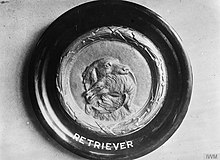HMS Starfish was an R-class destroyer which served with the Royal Navy. She was launched on 27 September 1916 and sold to be broken up on 21 April 1928. She was built by Hawthorn Leslie of Hebburn Tyne.

HMS Taurus was an R-class destroyer which served with the Royal Navy during World War I. Ordered from Thornycroft in 1915 and launched in 1917, the vessel operated as part of the Harwich Force until the end of hostilities. Shortly after entering service, Taurus formed part of the destroyer shield for the Royal Navy's bombardment of Ostend that successfully sank the German destroyer S20. After the War, the destroyer was reduced to the Reserve Fleet and sold to be broken up in 1930.

HMS Teazer was an R-class destroyer which served with the Royal Navy during World War I. The destroyer was launched in April 1917 and, on trial, proved to be one of the fastest afloat, exceeding 40 knots. Attached to the Harwich Force, the ship supported the monitors Erebus, Terror and Marshal Soult in the bombardment of Zeebrugge in May 1918 and one of the final sorties of the war in the October following. The destroyer also took part in operations off the coast of Heligoland with a flying boat on a lighter, although the aircraft failed to take off. After the war, Teazer was kept in reserve until being sold to be broken up in 1931 following the signing of the London Naval Treaty that limited total destroyer tonnage.
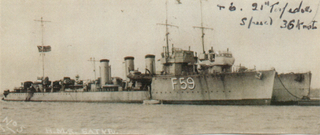
HMS Satyr was an R-class destroyer which served with the Royal Navy during the First World War. Launched on 27 December 1916, Satyr joined the Harwich Force under the command of Commander Hubert de Burgh. In 1917, the destroyer formed part of a force protecting the monitors Erebus and Terror in their bombardment of Ostend. As part of this action, Satyr, along with sister ships Taurus, Sharpshooter and Torrent, sank the German destroyer S20. After the war, the ship served with the Torpedo School at the Devonport. In 1923, the Navy decided to retire many of the older destroyers in preparation for the introduction of newer and larger vessels and Satyr was sold to be broken up on 16 December 1926.

HMS Thisbe was an R-class destroyer which served in the Royal Navy during World War I. The R class were an improvement on the previous M class with geared steam turbines to improve efficiency. Built by Hawthorn Leslie and launched on 8 March 1917, the destroyer served as part of the Harwich Force. In 1918, the destroyer towed a flying boat on a lighter to take part in operations off the coast of Heligoland, although the aircraft failed to take off. After the war, the destroyer was placed in reserve, and participated in trials with the Compass Department in 1925. The ship was sold to be broken up on 31 August 1936.

HMS Thruster was an R-class destroyer which served with the Royal Navy during the First World War. The R class were an improvement on the previous M class with geared steam turbines to improve efficiency. Built by Hawthorn Leslie and launched in January 1917, Thruster joined the Harwich Force, serving as part of a flotilla that escorted the monitors Erebus and Terror in their bombardment of Ostend in June that year. During the following month, Thruster, along with sister ship Springbok, captured the two German merchant ships SS Brietzig and SS Pellworm. The destroyer was also jointly credited with sinking the submarine UB-54 the following year. After the signing of the Armistice that ended the war, the destroyer was allocated to anti-submarine research and helped in the development of anti-submarine tactics with ASDIC. In April 1928, the ship took part in a high-speed demonstration for the King of Afghanistan, the Amanullah Khan, and, in January 1932, participated in the unsuccessful search for the crew of the submarine M2. Placed in reserve at the Nore in June 1936, Thruster was sold to be broken up in March 1937.

HMS Ursula was a Modified Admiralty R-class destroyer that served in the Royal Navy. The Modified R class added attributes of the Yarrow Later M class to improve the capability of the ships to operate in bad weather. The vessel was launched in 1917 at Greenock in Scotland and served with the Grand Fleet during the First World War. After the war, the destroyer was transferred to the Home Fleet, but then moved to the Reserve Fleet. In 1924, Prince George served aboard Ursula before, in 1929, the vessel was sold to be broken up.
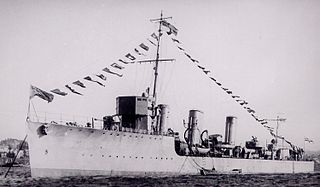
HMS Rapid was a destroyer of the M class that served with the Royal Navy during First World War. Launched by Thornycroft in 1916, the vessel was the one of two similar ships ordered as part of the Fifth War Construction Programme. They differed from the remainder of the M class in having more powerful engines. The design was used as the basis for the subsequent five ships of the R-class also built by the yard. Rapid served in escort and patrol roles, principally providing defence from submarines as part of the Grand Fleet until it was disbanded at the end of the War. After the end of hostilities, the vessel served in minor roles, including briefly as part of the Admiralty Compass Department in 1921 and 1924, but was sold to be scrapped in 1927.

HMS Ready was a destroyer of the M class that served with the Royal Navy during First World War. Launched by Thornycroft in 1916, the vessel was the one of two similar ships ordered as part of the Fifth War Construction Programme. They differed from the remainder of the M class in having more powerful engines. The design was used as the basis for the subsequent five ships of the R-class also built by the yard. Ready operated within the Grand Fleet until it was disbanded at the end of the war. The vessel was credited with helping to sink a German Q-ship in 1917. After the war, the destroyer was initially transferred to HMNB Portsmouth, but was retired and sold to be broken up in 1926 after almost a decade of service as part of a preparation for a fleet of new destroyers.

HMS Simoom was an R-class destroyer which served with the Royal Navy during World War I. Launched on 30 October 1916, the vessel operated as part of the Harwich Force until torpedoed by the German destroyer S50 on 23 January 1917. The ship's magazine exploded and 47 people died. The name was reused by the first S-class destroyer, Simoom, launched on 26 January 1918.
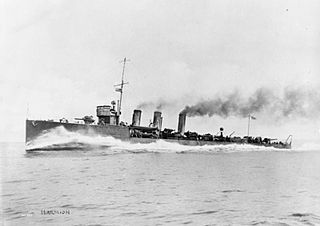
HMS Nereus was a Admiralty M-class destroyer which served with the Royal Navy during the First World War. Launched in 1916, the vessel served with the Grand Fleet until the end of the conflict. The vessel operated as part for Thirteenth Destroyer Flotilla in support of convoy operations. In 1918, the flotilla took part in one of the last sorties of the war, although the British and German fleets did not meet and the destroyer returned without seeing any action. After the conflict, the destroyer was worn out by the demands of high speed operation in poor weather. Nereus was decommissioned and sold to be broken up in 1921 after less than six years service.
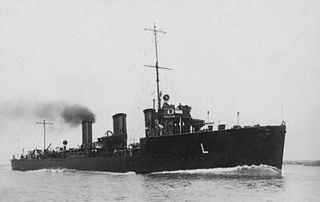
HMS Lochinvar was a repeat Laforey-class destroyer which served with the Royal Navy during the First World War. Named after the character in the poem Marmion, the ship was originally to be called HMS Malice but was renamed prior to being launched on 9 October 1915. The destroyer joined the Harwich Force and took part in anti-submarine patrols, as well as escorting the monitors Erebus and Terror for their attacks on the canal gates at Zeebrugge and the port of Ostend in 1917. After the Armistice, the vessel was placed in reserve and sold to be broken up on 25 November 1921.

HMS Penn was a Repeat Admiralty M-class destroyer which served with the Royal Navy during the First World War. The M class were an improvement on the preceding L class, capable of higher speed. The ship was named after William Penn, the father of the founder of Pennsylvania. Launched on 8 April 1916, the vessel served with the Grand Fleet forming part of the screen for the dreadnought battleships of the 1st Battle Squadron and escorting the aircraft carrier Furious in battle. The destroyer participated in the Actions of 19 August 1916 and 16 October 1917, as well as forming part of the distant support during the Second Battle of Heligoland Bight. Penn was also instrumental in rescuing the survivors from the light cruiser Nottingham, sunk by a German submarine. After the Armistice that ended the war, the destroyer was placed in reserve and subsequently sold to be broken up on 9 May 1921.

HMS Moorsom was an Admiralty M-class destroyer which served in the Royal Navy during the First World War. The M class was an improvement on the preceding L class, capable of higher speed. Moorsom, the first ship to enter navy service to be named after Admiral Sir Robert Moorsom, was launched in December 1914, initially serving as part of the Grand Fleet before being transferred to the Harwich Force the following year. Briefly rejoining the Grand Fleet, the destroyer saw service in the Battle of Jutland in 1916 supporting the British battlecruisers and received hits from a battleship of the German High Seas Fleet. Moorsom also undertook other duties, including escorting the troop ship Mauretania in June 1915 and the minelayer Princess Margaret in August 1915 and November 1916. Placed within the Dover Patrol, the destroyer formed part of the cover for monitors including Erebus and Terror on attacks on Ostend and Zeebrugge in May and June 1917, and April and May 1918. After the Armistice, the destroyer was placed in reserve and subsequently sold to be broken up in November 1921.

HMS Morris was an Admiralty M-class destroyer which served with the Royal Navy during the First World War. The M class were an improvement on the preceding L class, capable of higher speed. The ship, the only vessel to be named Morris to serve with the Royal Navy, was launched on 19 November 1914. Joining the Grand Fleet as part of a new flotilla, the destroyer was soon in action, serving as part of a destroyer screen during the Battle of Dogger Bank in January 1915 and an escort to the minelayer Princess Margaret during a skirmish with German torpedo boats eight months later. At the Battle of Jutland in 1916, the destroyer was a crucial part of the flotilla that drove the German torpedo boats away from the British battlecruisers. Morris received no hits during these confrontations. The destroyer assisted in the rescue of survivors from the R-class destroyer Simoom and the recovery of the damaged flotilla leader Botha in 1917. The ship also undertook general duties including escorting merchant ships, minelayers, monitors, and the seaplane carrier Vindex. After the armistice that ended the war, the destroyer was considered superfluous to requirements, Initially placed in reserve, Morris was decommissioned and, on 8 November 1921, sold to be broken up.

HMS Napier was a Repeat Admiralty M-class destroyer which served in the Royal Navy during the First World War. The M class were an improvement on the previous L-class destroyer, capable of higher speed. The vessel was launched on 27 November 1915 and joined the Grand Fleet. Napier had a varied war career, acting as part of the destroyer screen for the First Battle Squadron during the Second Battle of Heligoland Bight and searching for the survivors of losses like the armoured cruiser HMS Hampshire. The vessel was usually based at Scapa Flow but spent a brief time seconded to the Harwich Force in 1917. After the Armistice that marked the end of the First World War, Napier was placed in reserve before being decommissioned and sold to be broken up on 8 November 1921.

HMS Stork was an R-class destroyer that served in the Royal Navy during the First World War. The R-class were an improvement on the previous M-class with geared steam turbines to improve efficiency. Launched by Hawthorn Leslie at Hebburn in 1917, Stork joined the Harwich Force. The destroyer saw service escorting convoys in the English Channel and encountered both German submarines and torpedo boats, but did not record any hits on the enemy. The vessel also supported attacks on German forces on the coast of Western Europe by Coastal Motor Boats, flying boats and monitors, including the Zeebrugge Raid of 1918.

HMS Oberon was a Repeat Admiralty M-class destroyer which served in the Royal Navy during the First World War. The M class were an improvement on the previous L-class, capable of higher speed. The vessel was launched in 1916 and joined the Grand Fleet. Oberon joined the Thirteenth Destroyer Flotilla which, in 1917, participated in a large anti-submarine warfare operation in the North Sea. The sortie led to three German submarines being sunk, although Oberon was not directly involved in these attacks. In 1918, the flotilla was involved in one of the final sorties of the Grand Fleet, but again the destroyer saw no action at the time. After the Armistice that marked the end of the First World War, Oberon was placed in reserve, decommissioned and, in 1921, sold to be broken up.

HMS Myngs was an Admiralty M-class destroyer which served in the Royal Navy during the First World War. The M-class ships were an improvement on those of the preceding L class, capable of higher speeds. Myngs, the first ship to enter Royal Navy service to be named after Vice-Admiral Sir Christopher Myngs, was launched in 1914. initially serving as part of the Grand Fleet, the vessel was involved in escorting troop ships like RMS Mauretania before being transferred to the Harwich Force in 1915. Placed within the Dover Patrol, the destroyer continued to operate as an escort, as well as taking part in sorties against German warships. The vessel formed part of the cover for monitors including Erebus and Terror for an attack on Zeebrugge in 1918. Towards the end of the war, Myngs sank the monitor Glatton, which was alight following an internal explosion, with a single torpedo. After the Armistice, the destroyer was placed in reserve and subsequently sold to be broken up in 1921.

HMS Tetrarch was an R-class destroyer that served in the Royal Navy during the First World War. The R class were an improvement on the previous M class with geared steam turbines to improve efficiency. Launched in 1917, Tetrarch served with the Tenth Destroyer Flotilla of the Harwich Force. The destroyer took part in the First Ostend Raid in 1918 alongside the monitors Erebus and Terror. Later that year, the vessel escorted five destroyers each towing an aircraft on a lighter to attack German shipping off Heligoland. After the Armistice, the ship was initially placed in reserve at Devonport but soon joined the Atlantic Fleet, with a particular role as an escort to the aircraft carriers Courageous and Furious. As well as exercises with the fleet in the Mediterranean Sea and off the coast of Scotland, the ship undertook visits to seaside resorts in England and Wales. Following a decision to replace older destroyers in the Royal Navy, Tetrarch was retired in 1934 and sold to be broken up.

